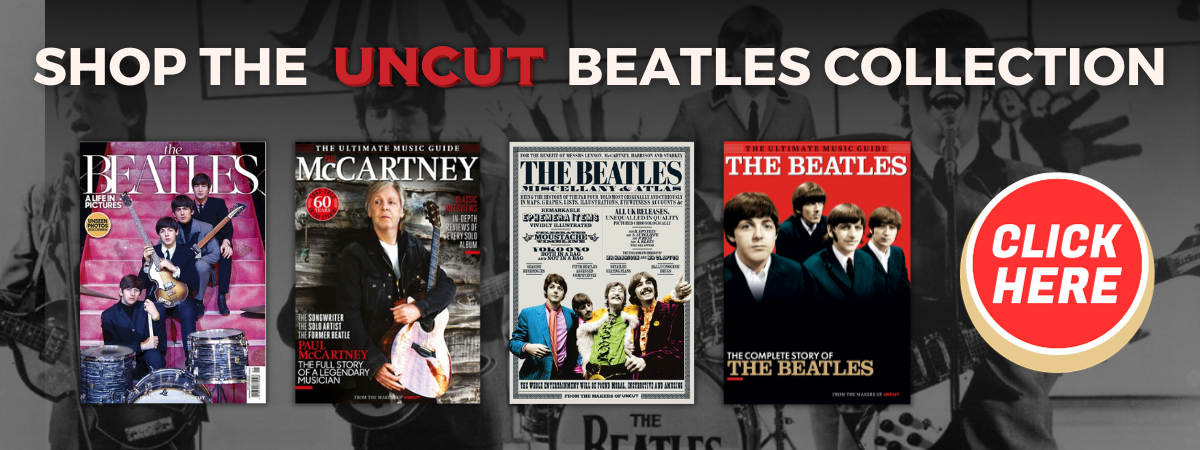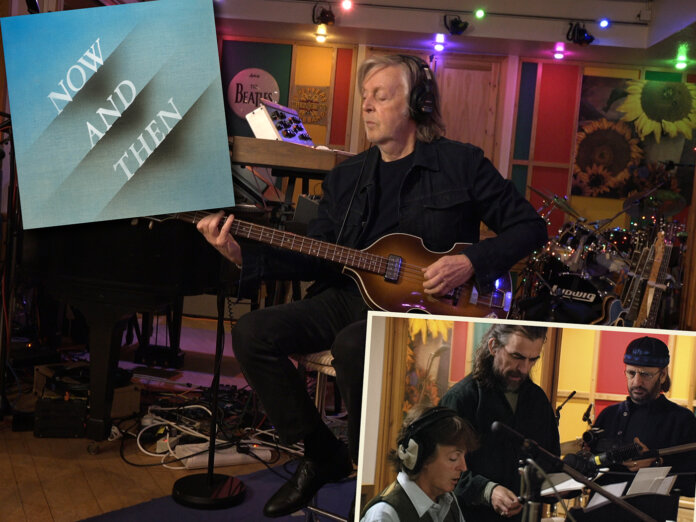In the world of The Beatles, now and then have increasingly gone hand in hand. 50 years of Sgt Pepper’s were celebrated with unreleased items from the vault, and an almost unthinkable new addition – a remix of one of the world’s most famous albums. The Get Back sessions, likewise were commemorated with Peter Jackson’s complete revisit of the audio/visual material from Twickenham and Savile Row. There was a Let It Be box set, of course – but also a new kind of reality series: by turns uncomfortable, thrilling and inspiring, put together with material restored using AI techniques.
In the world of The Beatles, now and then have increasingly gone hand in hand. 50 years of Sgt Pepper’s were celebrated with unreleased items from the vault, and an almost unthinkable new addition – a remix of one of the world’s most famous albums. The Get Back sessions, likewise were commemorated with Peter Jackson’s complete revisit of the audio/visual material from Twickenham and Savile Row. There was a Let It Be box set, of course – but also a new kind of reality series: by turns uncomfortable, thrilling and inspiring, put together with material restored using AI techniques.
ORDER NOW: Bob Dylan and The Review Of 2023 star in the latest UNCUT
In title and ethos, “Now And Then”, the new and apparently last Beatles song, fits well with that profile. Like a drama on BBC4, it’s something which takes place on several different timelines: originating in a late 1970s John Lennon demo, worked on but abandoned during the “Threetles” sessions for Anthology in 1995, and then picked up again by Paul McCartney in 2022. It’s a final – he thinks – look at the Beatle itch he hadn’t previously been able to scratch.

If you were being pedantic, you’d say that what we’re listening to here isn’t so much the Beatles as the Former Beatles – this being the work of men who by the time of Lennon’s demo or his death in 1980, were only in intermittent, and not always cordial, contact. Maybe it’s more reasonable to say that such was the immensity of what they accomplished as Beatles, it became the project of their creative lives as solo musicians to reconcile themselves with what had gone before. Easy enough for their much-admired Bob Dylan to say “Don’t look back”. For a Beatle, even John Lennon, it was always a little bit about the past.
No more so than for Paul McCartney, who has for decades occupied the role we see him adopting in Get Back: the driving force behind the Beatles, even in their afterlife. When he is of a mind to do something, he gets it done. To make ready this new song for release, he sprang into action. There was deep work in 2022 at his Hog Hill Studio in Sussex. New drums arrived from Ringo Starr in LA. Strings were added at Capitol Studios without the players knowing who wrote the song, or what the project was. George Harrison’s acoustic rhythm guitar parts were harvested from the 1995 tapes. A guitar solo was supplied by Paul in the George “When We Was Fab” slide guitar manner – though it’s not completely clear if George had attempted something in this vein in 1995 or not.
The only obstacle was the songwriter. Not only did John Lennon remain as not alive in 2022 as he was in 1995, his voice – as heard on the fabled “For Paul” cassette of his demos passed to McCartney by Yoko Ono – was often obscured by the noise of the TV in the background, and Lennon’s own dynamic piano playing. After extensive work by Emile de la Rey, Peter Jackson’s man at the MAL AI controls, Lennon’s singing has been extracted effectively and lives again: melodically certain, but with the ghostly edge of fractionally less than present-day fidelity.
That sound is the most immediately striking characteristic of the song – that is John Lennon again. The fullness of the mix, allowing the bass and drums free rein in the audio picture makes this a very modern-sounding piece. But the most remarkable thing about it isn’t the manner of its construction, or that sound, or the five decades lifetime that it spans: it’s the song.
As advanced as technology is, not even Paul McCartney can rewind the tape and make this a composition by the Beatles from, say, 1967 or 1969, as technology and drugs or domesticity and the piano ballad were changing their music. This is a song by a John Lennon who had rejected the Beatle version of himself, purged his music and come to some kind of domestic peace. But it is still a song by John Lennon – and bears the watermark of his slightly melancholic and experimental melodic sense.
Let’s not mislead anyone, it’s a mid-paced rock song, not the sound of a Tibetan monk on a mountaintop, but from its engaging Paul count-in to the Walrusy flourish of strings at the close four minutes later, it’s still a lot weirder than you might expect. It starts in a reflective mode, and – this being a mark of McCartney’s way of kickstarting things in the studio – when you think it can’t get any more minor, that’s where Ringo’s drums kick in and the song starts in earnest.
Like Ed Ruscha’s sleeve art, it’s pale and reflective, and when you think about the journey the song’s been on, that’s probably about right. As much as Lennon was in a confessional mode in the late 1970s, it’s not too fanciful to hear his chorus “Now and then I miss you…” as tapping into the same kind of public display of affection for the young Beatles that McCartney managed in “Two Of Us”. There’s a thoughtful conceptual unity to the entire project, to the extent that the single, in whatever manner it exists, will come with the band’s first single, “Love Me Do” on the flip.
McCartney apparently wanted “Now And Then” out in October 2022 and it’s been burning a hole in his pocket ever since. In June this year he bust his own record company embargo on the project and declared all to the BBC Today programme. As Uncut sits with a few others in a suite at the top of Abbey Road on October 19, we don’t only hear the new song, but also the efforts that have been underway to give the song an album-length mothership to reside in. It’s 50 years since the “red” (1962-1966) and “blue” (1967-1970) compilations, and it’s on the second of these expanded and remixed albums that the new song will reside.
As Jonathan Clyde from Apple Corps tells us, the song needed a video, which presented a challenge. Peter Jackson was asked but initially rejected the offer on the grounds that he generally tells his stories over several hours, not in four minutes. When he relented, he wanted to try something that would steer clear of “mawkishness” and what he’s done is definitely that. Rather than shoot for continuity where there is none, he’s instead created a bizarre film where McCartney, Starr and Harrison are joined in the studio in 1995 and 2022 by younger, playful versions of Lennon (and then Harrison) wearing their psychedelic Pepper finery.
That it’s 50 years since the red and blue comps is certainly one thing. November 2023 also marks an anniversary of something marvellous but less tangible. November 2 is almost precisely the 60th anniversary of John Lennon suggesting that some guests at the Royal Variety performance should clap their hands, while others rattle their jewellery. In so doing he helped unleash Beatlemania on the world, a joyful irreverent spirit which has never fully gone away.
Which may be is the ultimate point of “Now And Then”. To recognise there will always be a Beatles anniversary of one kind or another – but there will never truly be a last Beatles song.



